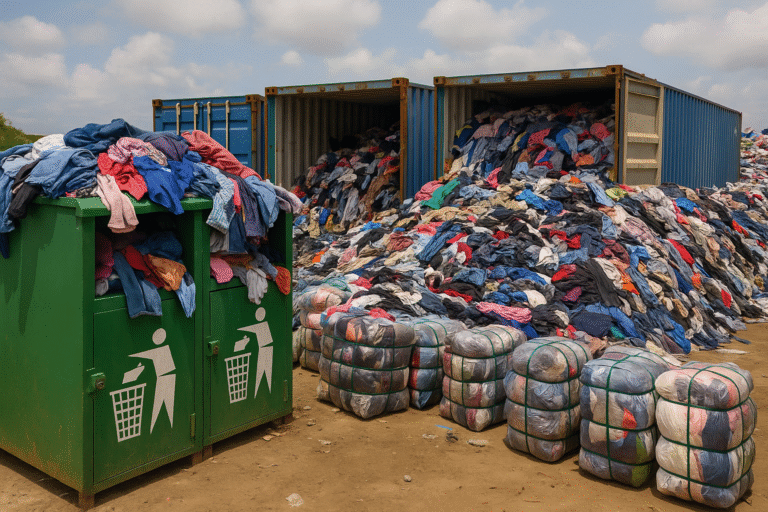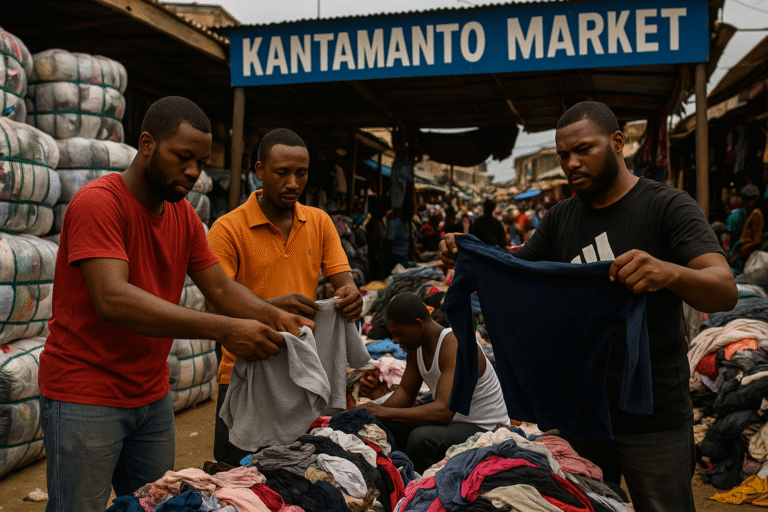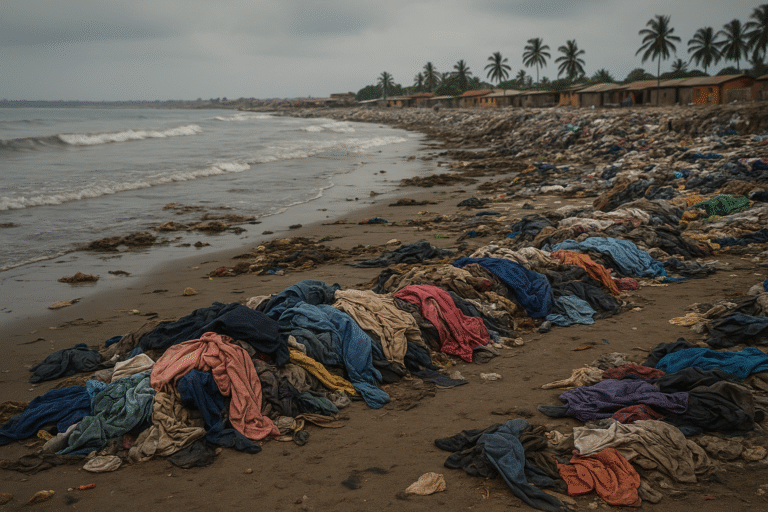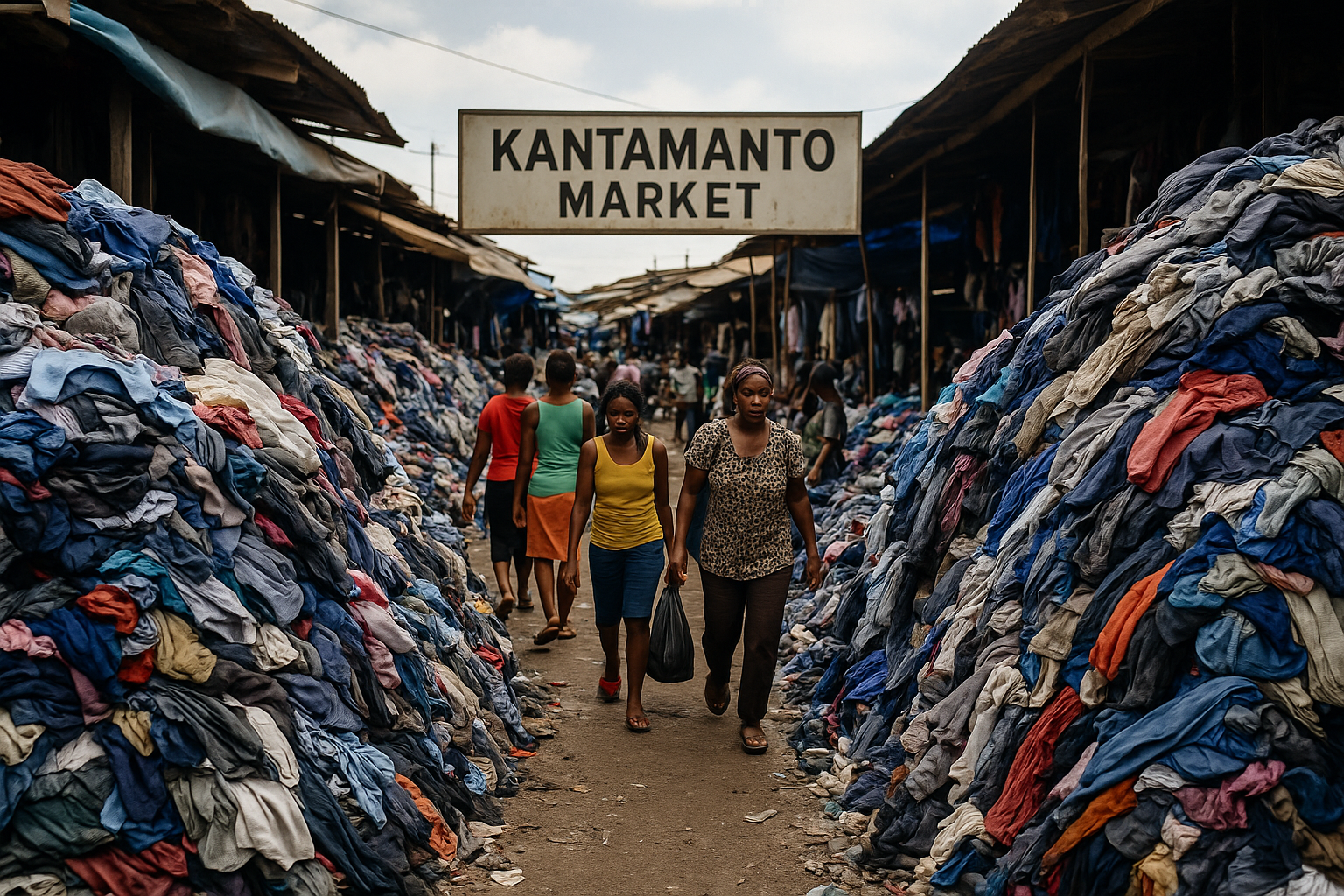The darker side of fast fashion first hit me when I was driving and heard a BBC News report about Ghana becoming one of the world’s largest dumping grounds for discarded clothes. At that moment, the glossy ads of runway looks and influencer hauls felt jarringly disconnected from the reality unfolding thousands of miles away.
Also, what shocked me wasn’t just the sheer scale — millions of garments shipped weekly under the banner of “donation” — but the fact that much of it was waste, never meant to be resold or reused. Likewise, the report revealed that communities in Accra, especially around the Kantamanto Market, were paying the price for an industry addicted to speed and excess.
So, while fast fashion presents itself as affordable glamour, Ghana’s story forces us to ask: what really happens to the clothes we throw away?
Jump To:
ToggleKey Takeaways on Ghana’s Clothing Waste Crisis
- Ghana imports about 225,000 tons of secondhand clothing each year — that’s nearly 15 million fast fashion garments every week.
- Up to 40% of imports become waste, creating huge disposal and pollution problems.
- Major exporters include the UK, EU, U.S., and China, offloading fast fashion waste under the label of “donations.”
- Local traders in Ghana shoulder the risks, often falling into debt when unsellable bales flood Kantamanto Market.
- Consumers can make a difference by buying fewer, higher-quality pieces, donating responsibly, and supporting circular fashion.

From Donation Bins to Kantamanto: Fast Fashion in Ghana
The darker side of fast fashion becomes clear when you follow the trail of our so-called “donations.” At first, it seems simple: clothes dropped into bins in London, New York, or Paris find a second life. However, the reality is far different. Instead of staying local, much of this clothing is packed into shipping containers and sent thousands of miles to Ghana.
The Scale of Ghana’s Fast Fashion Imports
- 225,000 tons annually — the equivalent of 15 million garments every week arrive in Ghana. (Time)
- Imports are worth over $160 million annually, showing this is big business, not small charity. (Trading Economics)
- Traders often find 40% of each bale unsellable: torn, stained, or too poor in quality (Earth.org)
- In one year, the UK sent 57,000 tonnes to Ghana — more than to any other country apart from the UAE. (Greenpeace UK)
What’s more, these statistics reveal a painful truth: what looks like generosity in the West often becomes a burden in Accra. Likewise, the glossy idea of recycling disguises the reality of waste.
In reality, the imports flooding Kantamanto Market are not simply donations — they are the hidden overflow of an industry addicted to speed and excess.
The Human Cost of Ghana’s Fast Fashion Imports
At Accra’s Kantamanto Market, traders shoulder risks that most consumers never think about. However, these men and women are the backbone of a trade system flooded with unpredictable quality. Also, every purchase is a gamble with real financial consequences.

The Trader’s Gamble: Fast Fashion Risks in Ghana’s Kantamanto Market
- Sealed bales of secondhand clothing (~55 kg each): Traders buy them blind, only discovering the contents after purchase — a risky gamble at the heart of Ghana’s fast fashion waste crisis.
- Debt and losses: With up to 40% of items unsellable, vendors must absorb the cost by taking on loans, trapping families in cycles of debt. (Earth.org)
- Declining quality: UK exports of used clothing to Ghana rose 77% in a decade, yet the value per kilogram dropped by 15% — proof that fast fashion waste has increased even as quality has declined. (Greenpeace Unearthed)
- Coping strategies: Traders work tirelessly to recover losses. Some pieces are upcycled into new garments, while others are sold cheaply just to clear stock. Still, the stress of gambling with poor-quality fast fashion waste takes a heavy toll, with families often working long hours just to break even.
Ultimately, the human cost is clear: fast fashion waste doesn’t only harm Ghana’s environment — it also undermines the livelihoods and dignity of those forced to manage it.
Fast Fashion Waste and Environmental Damage in Ghana
The darker side of fast fashion doesn’t stop with traders’ debt — it spills into Ghana’s environment. Unused and unsellable clothes often end up in dumpsites, drainage systems, or scattered across beaches.
In fact, the sheer scale of fast fashion textile waste is overwhelming, leaving entire ecosystems struggling to cope.

Environmental Fallout: Fast Fashion Waste in Ghana
- Wetlands at risk: Greenpeace traced UK brand clothing discarded in protected sites such as the Densu Delta Ramsar wetland, highlighting how fast fashion waste reaches even Ghana’s most fragile ecosystems. (Guardian)
- Polluted waterways: Reports show the Korle Lagoon in Accra clogged with discarded textiles, plastics, and dyes — clear evidence of how fast fashion waste contaminates Ghana’s water systems.
- Toxic impact: People burn unsellable garments releases hazardous chemicals, while synthetic fibers shed microplastics into the soil and rivers, threatening long-term environmental health.
Fashion waste creates a human cost: Communities near these dumpsites face serious health risks. Children play beside polluted waterways, families breathe toxic smoke from open-air burning, and fishers and farmers see their livelihoods collapse under the pressure of global overproduction.
In the end, Ghana pays a heavy environmental toll – a global fashion industry that thrives on disposability inevitably causes this outcome.
Who’s Responsible for Ghana’s Clothing Dumping Crisis?
After wetlands and waterways are choked with waste, one question becomes unavoidable: who is sending all these clothes to Ghana? The answer points to exporting nations and the fast fashion industry, both of which play central roles in this crisis. On top of that, what is framed as generosity is often a convenient way to shift waste offshore.
The Global Players in Ghana's Clothing Waste Crisis
- Major exporters: The UK, EU nations, China, and the U.S. are among the largest senders of used clothing to Ghana. (EEB)
- UK exports alone: In a single year, the UK shipped over 57,000 tonnes, second only to the UAE. (Greenpeace UK)
- Quality concerns: Greenpeace reports that traders discard only ~5% of clothes in newly opened bales, but traders say up to 60% of items in a bale can be “borla” — too low in quality to sell. (Greenpeace Report PDF)
Still, brands carry responsibility. Fast fashion chains drive overproduction, and rely on ‘take-back’ programs that critics argue cannot handle the scale of waste.
What’s more, when consumers believe donation bins or recycling drop-offs solve the problem, it only reinforces a cycle of overconsumption.
Lastly, while not every exported garment is poor in quality, much of the clothing reaching Ghana still turns into waste — leaving the country to carry the burden of an industry built on speed and disposability.
Solutions to Ghana’s Fast Fashion Waste Crisis
The crisis is daunting, but it isn’t without answers. Also, responsibility doesn’t rest on Ghana alone — it requires change from consumers, nations, and brands alike. Furthermore, small steps at every level can ease the burden and move fashion toward accountability.
The Path Forward: Solutions to Fast Fashion Waste in Ghana
- Consumers: Buy fewer, higher-quality pieces, avoid impulse trends, and donate only items in good condition. In doing so, individuals help reduce the flow of fast fashion waste and poor-quality garments from ending up in landfills.
- Nations: Push for Extended Producer Responsibility (EPR) laws that make brands responsible for the full life cycle of their products. For example, France has even proposed an EU ban on certain used clothing exports. (Reuters)
- Brands: Stop hiding behind small-scale recycling programs and address overproduction. True accountability means designing durable clothing, reducing production volumes, and creating a more sustainable fashion system.
- Local innovation in Ghana: Traders and entrepreneurs are upcycling waste into fashion, art, and even building materials, showing resilience and creativity in the face of overwhelming fast fashion imports. (Time)
In the end, real solutions demand a cultural shift — one where fashion is no longer disposable, but designed to last. When responsibility is shared across borders, Ghana no longer stands alone as the world’s dumping ground.
Quick Recap: Ghana’s Fast Fashion Waste Crisis
- Ghana imports about 225,000 tons of secondhand clothing annually — around 15 million garments every week.
- Up to 40% of these imports are waste — poor-quality, torn, or stained fast fashion that cannot be resold.
- Traders at Accra’s Kantamanto Market often fall into debt when bales contain unsellable items, fueling a cycle of financial strain.
- Unsold clothes pollute wetlands, rivers, and beaches, releasing toxins and microplastics into the environment.
- Major exporters — including the UK, EU, U.S., and China — fuel the crisis, shifting responsibility offshore.
- Fast fashion brands drive overproduction and rely on weak take-back programs that critics say cannot manage the scale of waste.
- Real solutions include buying less but better, donating responsibly, passing stronger global laws, and supporting Ghanaian innovation.
Lessons from the Darker Side of Fast Fashion
Ghana’s story reveals that the darker side of fast fashion doesn’t disappear when we drop clothes in a donation bin. Instead, it resurfaces in Accra’s markets, wetlands, and landfills. This shows the problem is not just Ghana’s — it is global, tied to our consumption habits and an industry addicted to overproduction.
Yet change is possible. What’s more, every consumer choice, every brand policy, and every export law can either continue the cycle or begin to break it. When fashion is made to last and donations are truly responsible, the burden shifts away from Ghana and toward a fairer system.
In the end, the lesson is clear: the clothes we discard still have a story — and in that story, we hold the power to choose a better ending.
FAQ: Fast Fashion Waste in Ghana
Q1: Why does Ghana import so much used clothing?
Because wealthy nations export millions of garments each week, often labeled as “donations” or “reuse.” As a result, Ghana has become one of the largest destinations for secondhand clothing.
Q2: Which countries send the most clothing to Ghana?
The UK, EU member states, China, and the U.S. are among the top exporters. In fact, in one year alone, the UK shipped over 57,000 tonnes of secondhand clothing to Ghana. (Greenpeace UK)
Q3: Is all secondhand clothing waste?
No. Good-quality garments can be reused or resold. However, the growing flood of low-quality fast fashion waste means much of it cannot be sold, creating serious environmental and economic challenges.
Q4: What can brands do to stop dumping?
Brands need to adopt Extended Producer Responsibility (EPR), cut overproduction, and design clothing to last. In addition, stronger global regulations are needed to hold the fashion industry accountable.
Q5: How can I, as a consumer, make a difference?
Buy fewer but better garments, support sustainable and transparent brands, and donate only clothes in good condition. In doing so, consumers help reduce the flow of fast fashion waste into Ghana.
If this article opened your eyes to the true cost of fast fashion, consider sharing it with a friend or colleague. Together, we can shine a light on the hidden impacts of clothing waste and inspire more people to make sustainable choices.



